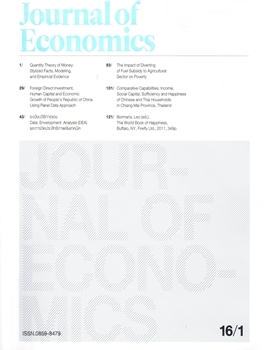THE IMPACT OF DIVERTING OF FUEL SUBSIDY TO AGRICULTURAL SECTOR ON POVERTY
Keywords:
Subsidy, Income Level, and Poverty, เงินอุดหนุน, ระดับรายได้, ความยากจนAbstract
The Indonesian government has been spending a big sum of money on fuel subsidy. However, studies show that fuel subsidy failed to hit the target group, i.e. the poor, effectively and at the same time fuel subsidy contributed to a budget deficit. To reduce the budget deficit, the government has started to reduce this subsidy gradually. Thus, the price of fuel has increased and at the same time there is a chain effect on the price of other goods and services. To lighten the burden of the people as a result of an increase in the price level, the government has introduced a direct cash aid to the poor. However, studies show that the transfer of payment to the poor is unable to offset the effect of an increase in the price level. Since majority of the poor lives in the rural area and most of them are farmers, this study explores an alternative policy in which the amount saved from a reduction in fuel subsidy is re-distributed to agricultural sector. Agricultural subsidy can be in the forms of inputs and price subsidy with the objectives of to help the farmers to increase production and efficiency.
Thus, the purpose of this study is to analyze the impact of the transfer policy of fuel subsidy to the food crops and other crops sub-sectors on the level of income and poverty. The major food crops are rice, corn, cassava and soybean. Most of the food crops are consumed domestically. Other crops refer to plantation crops such as oil palm, rubber, sugarcane and cocoa. These crops are exports crops. This study employs a Computable General Equilibrium (CGE) model to simulate poverty measures such as head count, poverty gap, and poverty severity indices. The poverty indices developed by Foster-Greer-Thorbecke (FGT) are used to measure poverty. It is found that the transfer of fuel subsidy to food crops sub-sector show a mixed results. If the percentage of the transfer of the subsidy is big enough, it will be able to increase income for all groups of household, except for the urban poor. Also, the simulation results show that the poverty gap and severity among the rural poor are improved. But, as a result of a decrease in income, the poverty gap and severity among the urban poor become worse off. The transfer of fuel subsidy to other crops sub-sector, i.e. plantation crops, shows an increase in the level of income for all household groups. Thus, the number of rural- and urban-poor households is decreased. Poverty gap and severity among these two groups of households are also improved. However, the diversion of fuel subsidy to other crops sub-sector has a bigger impact on poverty reduction as compared to the transfer of fuel subsidy to the food crops sub-sector.
วัตถุประสงค์ของการศึกษาเพื่อต้องการวิเคราะห์ของนโยบายการถ่ายโอนของการอุดหนุนเชื้อเพลิง ของภาคกสิกรรม และพืชที่เกี่ยวข้องต่อระดับรายได้และความยากจนในประเทศอินโดนิเซีย การศึกษาในครั้งนี้ใช้แบบจำลองดุลยภาพ ครอบคลุม Computable General Equilibrium (CGE) ในการจำลองการวัดความยากจน เช่น การนับหัว ช่วงห่างความ ยากจน poverty gap, และดัชนีความรุนแรงของความยากจน ดัชนีความยากจนพัฒนาโดย Foster-Greer-Thorbecke (FGT) นำมาใช้ในการวัดความยากจน ผลที่ได้จากการจำลองจะแสดงให้เห็นถึงการถ่ายโอนการอุดหนุนเชื้อเพลิงต่อภาคกสิ กรรมและภาคเกษตรชนิดอื่นที่ทำให้เกิดความยากจนลดลง อย่างไรก็ตามความเบี่ยงเบนของการอุดหนุนเชื้อเพลิงต่อภาคกสิกรรมขนาดเล็กอื่นๆ ส่งผลมากกว่าต่อการลดลงของความยากจนมากกว่าเมื่อเทียบกับการใช้นโยบายอุดหนุนเชื้อเพลงกับภาคกสิกรรม
ผลการศึกษาแสดงให้เห็นว่าการลดลงของการจ่ายเงินอุดหนุนเชื้อเพลิง และเมื่อเทียบเป็นจำนวนเดียวกันเมื่อใช้ กับภาคเกษตรจะไม่ทำให้ความยากจนเพิ่มขึ้น ซึ่งในความเป็นจริงแล้วนั้นการศึกษาครั้งนี้พบว่าอัตราความยากจนลดลง นั้นเป็นผลมาจากการจำลองการใช้นโยบายดังกล่าว
Downloads
Issue
Section
License
All opinions and contents in the CMJE are the responsibility of the author(s). Chiang Mai University Journal of Economics reserves the copyright for all published materials. Papers may not be reproduced in any form without the written permission from Chiang Mai University Journal of Economics.
ข้อคิดเห็นที่ปรากฏและแสดงในเนื้อหาบทความต่างๆในวารสารเศรษฐศาสตร์มหาวิทยาลัยเชียงใหม่ ถือเป็นความเห็นและความรับผิดชอบโดยตรงของผู้เขียนบทความนั้นๆ มิใช่เป็นความเห็นและความรับผิดชอบใดๆของวารสารเศรษฐศาสตร์ มหาวิทยาลัยเชียงใหม่
บทความ เนื้อหา และข้อมูล ฯลฯ ในวารสารเศรษฐศาสตร์มหาวิทยาลัยเชียงใหม่ ถือเป็นลิขสิทธิ์เฉพาะของคณะเศรษฐศาสตร์มหาวิทยาลัยเชียงใหม่ หากบุคคลหรือหน่วยงานใดต้องการนำทั้งหมดหรือส่วนหนึ่งส่วนใดไปเผยแพร่ต่อหรือเพื่อกระทำการใดๆ จะต้องได้รับอนุญาตเป็นลายลักษณ์อักษร จากวารสารเศรษฐศาสตร์ มหาวิทยาลัยเชียงใหม่






